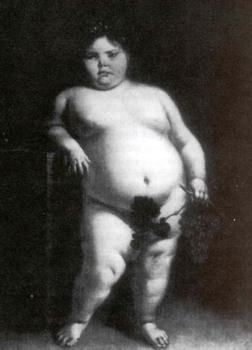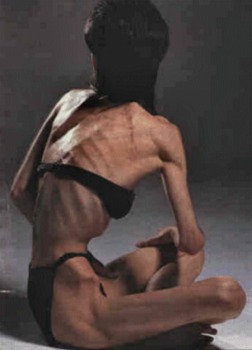Characterized by the obsession with eating healthy foods, this disease can be confused with and/or diagnosed as anorexia; the main difference being the reasoning behind the eating habits. Anorexics are obsessed with losing weight, while orthorexics feel a need for healthy or “pure” foods. Orthorexia is not recognized by the DSM IV and in general will not be diagnosed, but it is seeing a greater stronghold across the US. You can read the tragic story of a young woman who ultimately succumbed to orthorexia here.
PWS is caused by a chromosomal defect. It is non hereditary and it affects both sexes and all races. PWS can bring with it a number of symptoms including motor skill deficiency, incomplete growth, and mental retardation. In addition, PWS causes an unquenchable appetite. Left unchecked, sufferers can literally eat themselves to death. Treatment includes growth hormone and a low-cal diet that absolutely must be maintained. A fictionalized account of Prader-Willi was seen on the show CSI in 2005.
Pica is perhaps the most interesting disease on this list. It is both an eating disorder and a psychiatric problem. People with pica feel a compulsion to eat non-nutritional and non-food items. These can include anything from cigarette butts to paint. It is quite easy to get sick or even die from pica as the sufferer can eat dangerous chemicals or sharp objects that can puncture their vital organs.
Often called the opposite of anorexia, bigorexia is the only disorder on this list with more male sufferers than women. Bigorexics compulsively work out, take supplements, and severely restrict their diets. No matter how muscular and sculpted their bodies are, those with the disease are shy or even humiliated to show off their bodies because in their minds they just aren’t good enough. Statistics vary widely, as in addition to the embarrassment from the illness, eating disorders have long been seen as a women’s or girl’s disease and many men will not come forward.
Binge eating is a separate condition than bulimia. It is thought to be the most common eating disorder, yet is specified in the DSM IV as a part of EDNOS, or Eating Disorder Not Otherwise Specified. This is a broad category of ED and you can read about the criteria for EDNOS here. BED sufferers do not have the love of food most compulsive orders do. Like anorexics and bulimics, binge eaters are ashamed of their bodies and generally are embarrassed about their eating habits.
While not technically an eating related illness in and of itself, it is almost never diagnosed without the presence of another eating disorder. As the name suggests, a person with anorexia athletica goes beyond the normal feeling most of us have after a nice long run or a good session in the gym. The feeling is not optional for those with the disease, and they will often push themselves to over exertion or even serious injury to achieve the perfect body.
NES is a new disorder, yet like orthorexia is gaining in diagnosis. Night eating sufferers- usually obese or morbidly obese, eat almost nothing in the morning and during the day and eat over half of their daily calories at night. They often experience insomnia or wake up to indulge as well. Like others with and ED, people with NES are often secretive about their habits and are loathe to admit there is a problem.
While BDD can be diagnosed without the presence of an ED, is is nearly almost diagnosed along with the “big two” and often lingers long after other symptoms have lessened. People with BDD are convinced they have any number of defects, including but not limited to being fat and ugly,and having bad hair, bad teeth, and a bad odor. This goes beyond the normal teenage insecurities about how someone looks. When a BDD sufferer looks in the mirror, they see something completely different than those around them do.
Bulimia is characterized by binge/purge cycles. When most people think of bulimics, they think of self induced vomiting to purge. While this is one of the most common ways to purge, bulimics will also use diuretics and enemas. Additionally, bulimics will use ipecac syrup or over exercise to induce vomiting. Bulimics are very aware that their behavior is both abnormal and frowned upon and will go to great lengths to hide it. Interestingly, bulimics with a balanced binge purge cycle are generally a normal weight. It is only those who purge more than they binge who exhibit the outside signs of an eating disorder.
Newest studies estimate that 1 out of 100 teenage girls suffer from anorexia. Girls as young as 8 have been hospitalized with the condition. Brain mapping of those with anorexia shows their addiction to not eating is just as great as those with heavy drug or alcohol addiction. Anorexics are at great risk for relapse because anorexia and other eating disorders, like most addictions, never go away. Those that have been through treatment and no longer show symptoms or signs of their condition are considered in remission and must keep their impulses and urges in check. Even years down the line, one event can re-trigger the illness. However, those who do manage to keep the disease in line can recover fully and live and eat normally. Contributor: Callie
























